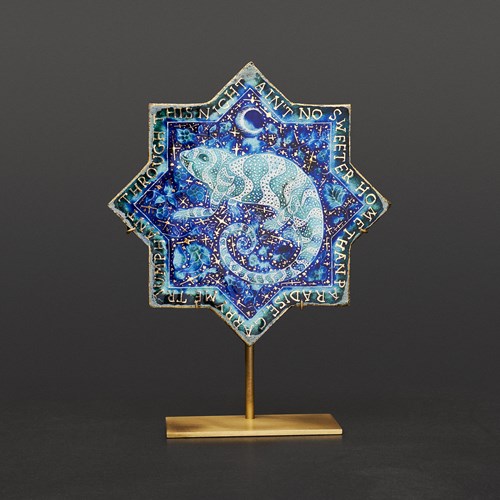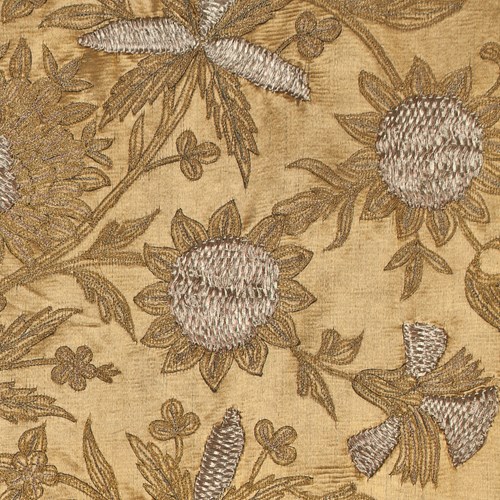Marketplace
Hispano-Moresque charger
Hispano-Moresque charger
Period Mid 16th century
Origin Manises, Spain
Medium Glazed and lustre-painted earthenware
Dimension 40.5 cm (16 inches)
This shimmering large lustre charger is covered in creamy-white tin glaze and painted in blue and brown copper lustre. The brim and the well are divided by a thick and solid brown line with additional thin lines parallel to it. The central raised boss is coloured in brown with a stylised leaf in the centre. The raised part of the boss is moulded with radiating concaved lines. The well contains four brown teardrop shapes arranged in cruciform, outlined in cobalt blue enclosing highly stylised leaf motifs. The background of the well contains motifs including trees and flowers. The brim contains moulded brown leaves outlined in blue against a background of flower and tree motifs. The design on the reverse, painted all in brown copper-lustre, is typical of the sixteenth century; it is painted with a central rosette surrounded by concentric circles, the reverse of the brim has fern leaves and whorls. A hole pieced at the well designed for suspension.
The techniques of lustre and opaque white tin-glaze, both originated from the Middle East, were brought to the Iberian Peninsula in the 8th century during the Umayyad conquest. The lustre technique uses glaze that contains silver- and copper-salt, resulting in the shiny and metallic look in ceramics after firing. The opaque white tin-glaze imitates the white colour of Chinese porcelain, which was considered a luxurious commodity in the medieval period. Although Islamic characteristics can still be observed on pottery produced in al-Andalus in the 13th century, local potters have developed an extensive set of decorative vocabulary native to Spain by the 15th century. This includes not only animal and vegetal designs, but also shields of arms from prominent families for products that were custom made. Spanish lustreware reached its height between the 14th-16thcentury, evidenced by an explosive range of highly sophisticated designs. This charger is a very rare late example of lustreware in this region, as religious expulsion and Renaissance impacted later production to shift focus on Europeanised figural representations.
Comparative material:
Paris, musée de Cluny - musée national du Moyen Âge (CL9616; CL9619)
Stock No.: A5402
The techniques of lustre and opaque white tin-glaze, both originated from the Middle East, were brought to the Iberian Peninsula in the 8th century during the Umayyad conquest. The lustre technique uses glaze that contains silver- and copper-salt, resulting in the shiny and metallic look in ceramics after firing. The opaque white tin-glaze imitates the white colour of Chinese porcelain, which was considered a luxurious commodity in the medieval period. Although Islamic characteristics can still be observed on pottery produced in al-Andalus in the 13th century, local potters have developed an extensive set of decorative vocabulary native to Spain by the 15th century. This includes not only animal and vegetal designs, but also shields of arms from prominent families for products that were custom made. Spanish lustreware reached its height between the 14th-16thcentury, evidenced by an explosive range of highly sophisticated designs. This charger is a very rare late example of lustreware in this region, as religious expulsion and Renaissance impacted later production to shift focus on Europeanised figural representations.
Comparative material:
Paris, musée de Cluny - musée national du Moyen Âge (CL9616; CL9619)
Stock No.: A5402
Period: Mid 16th century
Origin: Manises, Spain
Medium: Glazed and lustre-painted earthenware
Dimension: 40.5 cm (16 inches)
More artworks from the Gallery









